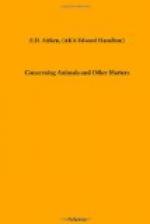But of beasts that graze and browse, a large number have turned their tails rather to a use which throws a pathetic light on misery of which we have little experience. We do, indeed, growl at the gnats of a summer evening and think ourselves very ill-used. How little do we know or think of the unintermitted and unabated torment that the most harmless classes of beasts suffer from the bands of beggars which follow them night and day, demanding blood, and will take no refusal. Driven from the brow they settle on the neck, shaken from the neck they dive between the legs, and but for that far-reaching whisk at the end of the tail, they would found a permanent colony on the flanks and defy ejection, like the raiders of Vatersay. Darwin argues that the tail-brush may have materially helped to secure the survival of those species of beasts that possessed it, and no doubt he is right.
The subject is interminable, but we must give a passing glance to some quixotic tails. The opossum scampers up a tree, carrying all her numerous family on her back, and they do not fall off because each infant is securely moored by its own tail to the uplifted tail of its mother. The opossum is a very primitive beast, and so early and useful an invention should, one would think, have been spread widely in after time; but there appears to be some difficulty in developing muscles at the thin end of a long tail, for the animals that have turned it into a grasping organ are few and are widely scattered. Examples are the chameleon among lizards, our own little harvest mouse, and, pre-eminent above all, the American monkeys. To a howler, or spider-monkey, its long tail is a swing and a trapeze in its forest gymnasium. Humboldt saw (he says it) a cluster of them all hanging from a tree by one tail, which proceeded from a Sandow in the middle. I should like to see that too. It is worth noting, by the way, that no old-world monkey has attained to this application of its tail.
Then there is the beaver, whose tail I am convinced is a trowel. I know of no naturalist who has mentioned this, but such negative evidence is of little weight. The beaver, as everybody knows, is a builder, who cuts down trees and piles log upon log until he has raised a solid, domed cabin from seven to twenty feet in diameter, which he then plasters over with clay and straw. If he does not turn round and beat the work smooth with his tail, then I require to know for what purpose he carries that broad, heavy, and hard tool behind him.
How few even among lovers of Nature know why a frog has no tail! The reason-is simply that it used that organ up when it was in want. In early life, as a jolly tadpole, it had a flourishing tail to swim with, and gills for breathing water, and an infantile mouth for taking vegetable nourishment. But when it began to draw near to frog’s estate, serious changes were required in its structure to fit it for the life of a land animal. Four tiny legs appeared




